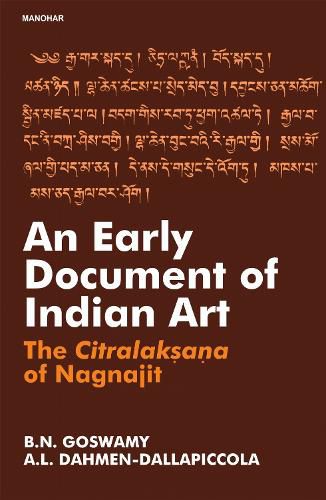Readings Newsletter
Become a Readings Member to make your shopping experience even easier.
Sign in or sign up for free!
You’re not far away from qualifying for FREE standard shipping within Australia
You’ve qualified for FREE standard shipping within Australia
The cart is loading…






Among the earliest works on the canons of Indian art, the Citralak]sa]na of Nagnajit is presented?here?for?the?first?time?in?an?English?translation.
Written in Sanskrit probably in the Gupta period, lost to Sanskritists for nearly a thousand years, known to Tibetans from the medieval times, and translated into German in the early years of the last century, here is a work of great antiquity and significance. The work is to be carefully distinguished from the Citralak]sa]na chapter in the sixteenth century text of Sri Kumara's Silparatna from which it is separated by close to a millennium. It is a text of considerable importance not only for the understanding of the early art of India but also for that of other countries in Asia including Tibet, Mongolia and even China. In addition to dealing with Chitravidya and its origins, it affords a fascinating glimpse into the minds of the theoreticians and artists of the past, with its elaborate details of iconometry, and its emphasis on the all-subduing figure?of?the?Cakravartin,?the?wheel-turning?Master.
The work as now published contains the English rendering of Citra-lak]sa]na based on Berthold Laufer's German translation, the complete Tibetan text (upon which the German translation was based) and also, in their entirety, Berthold Laufer's learned introduction and annotations as translated from German. Berthold Laufer (1874-1934) was a celebrated German?anthropologist?and?orientalist.
$9.00 standard shipping within Australia
FREE standard shipping within Australia for orders over $100.00
Express & International shipping calculated at checkout
Among the earliest works on the canons of Indian art, the Citralak]sa]na of Nagnajit is presented?here?for?the?first?time?in?an?English?translation.
Written in Sanskrit probably in the Gupta period, lost to Sanskritists for nearly a thousand years, known to Tibetans from the medieval times, and translated into German in the early years of the last century, here is a work of great antiquity and significance. The work is to be carefully distinguished from the Citralak]sa]na chapter in the sixteenth century text of Sri Kumara's Silparatna from which it is separated by close to a millennium. It is a text of considerable importance not only for the understanding of the early art of India but also for that of other countries in Asia including Tibet, Mongolia and even China. In addition to dealing with Chitravidya and its origins, it affords a fascinating glimpse into the minds of the theoreticians and artists of the past, with its elaborate details of iconometry, and its emphasis on the all-subduing figure?of?the?Cakravartin,?the?wheel-turning?Master.
The work as now published contains the English rendering of Citra-lak]sa]na based on Berthold Laufer's German translation, the complete Tibetan text (upon which the German translation was based) and also, in their entirety, Berthold Laufer's learned introduction and annotations as translated from German. Berthold Laufer (1874-1934) was a celebrated German?anthropologist?and?orientalist.